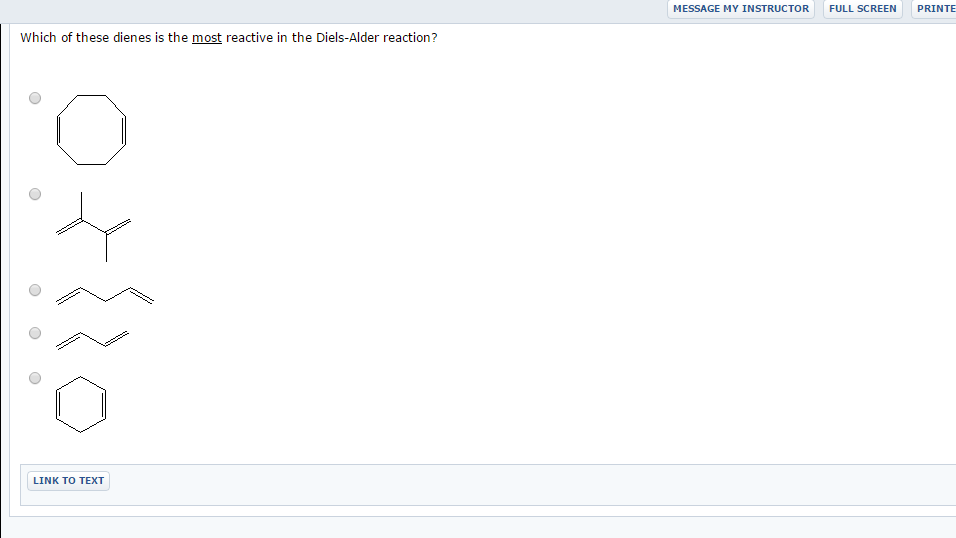

The previous diagram shows what appears to be a cyclohexene ring with a carbon bridge connecting the third and sixth carbons. If the diene is a ring structure, the Diels‐Alder reaction produces a bicyclic ring system.Ī bicyclic ring system has two carbon rings that share common sides. three types of reactivity modes (diene reactivity and vinylogous reactivity. An example of this stereospecificity is the reaction of 1,3‐butadiene with cis‐diethylmaleate.īecause the reaction is basically a concerted cyclization, the diene must react in the cis conformation. despite the fact that the reactive enamine intermediate was first prepared. The original stereochemistry of the diene and the dienophile are preserved during this syn‐addition reaction. The Diels‐Alder reaction is very ste‐reospecific.

Electron‐supplying groups on the diene make the electrons of the π system more available for reaction.ĭiels‐Alder stereochemistry. A good dienophile generally has one or more electron‐withdrawing carbonyl groupsĪttached to it. Reactive groups are categories of chemicals that typically react in similar ways because they are similar in their chemical structure. Simple alkenes and alkynes are not good dienophiles. Instead, this reaction proceeds by a pericyclic process, a mechanism of just one step, involving a cyclic redistribution of bonding electrons. The mechanism for the Diels‐Alder reaction shows that it does not run via a carbocation intermediate. Disubstituted dienes are challenging reaction partners for this. The Diels‐Alder reaction is favored by the presence of electron‐withdrawing groups on the diene and electron‐releasing groups on the dienophile, which is a group or bond that is attracted to a diene. For dienes 41 and 42, the reactions were performed with Cu (OTf)0.5PhMe (5 mol) and L1 (7 mol ) for 5d. A typical example is the reaction of 1,3‐butadiene with maleic anhydride. This reaction produces a 1,4‐addition product. The Diels‐Alder reaction is a cycloaddition reaction between a conjugated diene and an alkene. Cahn‐Ingold‐Prelog RS Notational System.Racemic Mixtures: Resolving Enantiomers The reactions of the metallocene dichlorides (5-C5H5)2MCl2, M Ti and Zr, with the 1,4-di-tert-butyl-1,4-diazabuta-1,3-diene radical anion (lithium.Cyclohydrocarbons: Reactivity, Stresses of Small Rings.DielsAlder reaction of substituted furans with reactive dienophiles such as. Alkynes: Molecular and Structural Formulas The DielsAlder reaction is the reaction between a conjugated diene and an.Alkenes: Oxidation and Cleavage Reactions The Diels-Alder Reaction 32 Stereochemistry of the Diels-Alder Reaction The Diels-Alder reaction is stereospecific i.e. DIENE STRUCTURE AND REACTIVITY For purposes of indicating the scope and limitations of the reaction, as developed to the present time, structural effects.The DielsAlder reaction is favored by the presence of electronwithdrawing groups on the diene and electronreleasing. The results preluded that the polarity and charge transfer flow between diene and dienophiles was consistent with the global reactivity descriptors and. A typical example is the reaction of 1,3butadiene with maleic anhydride. This reaction produces a 1,4addition product.
DIENE REACTIVITY PDF
Alkenes: Electrophilic Addition Reactions The DielsAlder reaction is a cycloaddition reaction between a conjugated diene and an alkene. Request PDF A DielsAlder Study of the Diene Reactivity of 2-Methyl-5-vinyl-3-furoate Esters The reaction of a range of dienophiles with methyl.Alkenes: Catalytic Addition of Hydrogen.Alkenes: Hydration (Direct Addition of Water).Alkenes: Molecular and Structural Formulas.Alkanes: Molecular and Structural Formulas.Brønsted‐Lowry Theory of Acids and Bases.This is because electron donating substituents on the diene decrease the gap between the HOMO of the diene and LUMO of the dienophile. We report the X-ray crystal structures of these complexes, and discuss their reactivity patterns and solution fluxional properties. Dienes with electron donating substituents (such as methoxy groups) would be more reactive that electron-poor dienes (in the normal demand Diels-Alder). T1 - Reactivity variations within Group 4 complexes of 1,4-di-tert-butyl-1,4-diazabuta-1,3-diene: Structures of through the elimination of Li(C5H5) and/or LiCl, respectively.


 0 kommentar(er)
0 kommentar(er)
